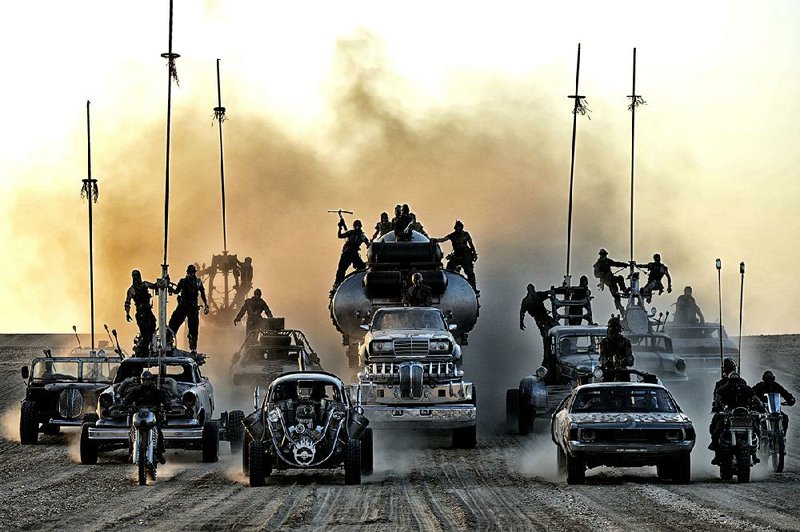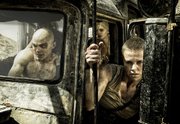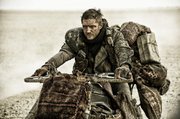When Aussie director George Miller made the first Mad Max film back in 1979, it wasn't necessarily to set the action-movie world ablaze, at least outside the cozy environment of the post-Armageddon desert hellscape in which the film was set. Utilizing the spare, unforgiving Outback as a backdrop, the film was exactly the kind of bloody revenge thriller that was cheap to make (a reported budget of $650,000) and popular enough so investors could expect a decent return on investment.
The film starred a young, as yet unblemished Mel Gibson as Max Rockatansky, a decent cop trying to keep the peace between rival gangs of leather-clad goons before his family gets killed and he is driven completely, vengefully insane. Thrilling and edgy, it went on to gross more than $100 million worldwide and became popular enough to beget two very successful sequels (the brilliant The Road Warrior and the less so Beyond Thunderdome).
Mad Max: Fury Road
89 Cast: Tom Hardy, Charlize Theron, Hugh Keays-Byrne, Nicholas Hoult, Zoe Kravitz, Rosie Huntington-Whiteley, John Howard
Director: George Miller
Rating: R, for intense sequences of violence throughout, and for disturbing images
Running time: 120 minutes
Gibson was the star, but the driving force was Miller, a former emergency room doctor turned gonzo action film auteur. It's possible his original vision used the Outback because it was cheap, and allowed him the space and wherewithal to produce epic, glorious stunts without much interference, from studios or anyone else, but whatever the reason, it became an indelible association. The way Woody Allen's best films use New York as a singular character, so, too, do Miller's use the gorgeous desert of his home country.
Not that the studios wouldn't have tried in a heartbeat, but it was almost impossible to imagine a Max film without Miller helming it, so it's affirming to see him behind the camera again, with the brilliant Tom Hardy replacing Gibson in the title role, and given a budget substantial enough to allow Miller to bring his spirited vision to full throttle.
Reportedly, Miller had planned Mad Max: Fury Road back in 1998, so it had come to be something of a white whale for the now-70-year-old director, one we are all lucky for him to have finally landed. The happy result is a summer blockbuster that sets the bar incredibly high for action films yet to come.
In keeping with the stark landscape (though now mostly filmed in Namibia), the plot is fairly minimal. One minute Max (Hardy) is minding his own business staring out over the desert countryside of his ruined world, with the ghosts of loved ones he couldn't save echoing in his mind; the next he's being abducted by a rabid group of shirtless skinhead lunatics in white body powder. He is taken to the cliff-dwelling kingdom of the Wasteland, where he is used as a forced blood-bag donor for Nux (Nicholas Hoult, a long, long way from selling us a sleek Jaguar), a young War Boy anxious to serve the enclave's renowned leader, Immortan Joe (Hugh Keays-Byrne), now a decrepit old man propped up by airbags and Plexiglas armor.
Chosen to accompany the renowned warrior Furiosa (Charlize Theron), a fierce woman with a bionic arm and a Blade Runner sense of eye shadow, as she and her team plan to take a huge rig over to an outlying fuel supplier, Nux takes along Max, propped on the front of his dune buggy like a chained-up figurehead. When Furiosa pulls an unexpected betrayal, stealing away Joe's stunning Five Wives -- including Toast the Knowing (Zoe Kravitz) and The Splendid Angharad (Rosie Huntington-Whiteley) -- in order to take them to freedom and the "Greenland" she remembers from her childhood, Nux and Max are caught up in the resulting battle royale and forced to accompany the women, with Joe and several other marauding gangs close on their tail. Thus ensues a hot fireball of exquisitely designed, meticulously gorgeous insanity, with countless chase scenes, punch-'em-ups, and wild, wide-lens mayhem.
Despite the presence of thespian heavy hitters such as Theron and Hardy -- who here mostly speaks short, declarative sentences ("My world is blood and fire," he says early on, with no further elaboration needed) in yet another peculiar low-register growl -- the real star of this giant-tire vehicle is the colorful carnage Miller has cooked up. The director, and his cinematographer, the brilliant John Seale, who reportedly came out of retirement for this project, bring us porcupine-like cars with giant metal spokes blowing apart, giant sandstorms that suddenly engulf the combatants like raging, brown hurricanes, warriors balanced from their cars on teeter-totter sticks swinging into and out of bright-orange explosions, and all with the pair's hyperactive cameras sweeping in and out of orbit of the action.
Working from a script he co-wrote with ingenious comics writer Brendan McCarthy and Nick Lathouris, Miller has spent considerable time designing the nature and modus operandi of each rival gang -- this isn't some sort of Warriors-like gig where the only difference between one group and another is hockey masks. Joe's War Boys worship him absolutely, anticipate their arrival at Valhalla when they die in service to him, and, in anticipation of imminent death, spray their mouths with a blast of silver paint to emulate the "chrome" they so admire on their cars.
Such small, fascinating details abound in the film's lexicon: Another king in the pursuit, the obese People Eater (John Howard), wears a silver metallic nose with a small watch chain attached; another king pulls bullets from his gumline. There are histories here, implied just enough to make this brutal fantasia all the more engrossing.
There's also a delightful, chaotic energy to the whole enterprise -- sadly uncommon to the standard, by-the-book computer-generated stylings of most studio summer fare -- aware of its own ridiculous excesses, the way early Sam Raimi films would add just enough sped-up movement and sardonic fatalism to give the action an amusing comic-book sheen. Fury Road isn't a grim post-apocalyptic vision that makes you want to go home and pull the bedsheets over your eyes; it fully embraces its own lunacy, which makes it all the more a fun, exhilarating ride. Unlike the third installment, Beyond Thunderdome, the film refuses to get bogged down in droning plot exposition or wispy character interplay. As Max himself suggests, Miller has gone with fire and blood this go-round, and we're all the better for it.
MovieStyle on 05/15/2015



